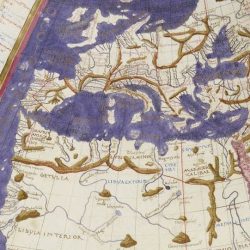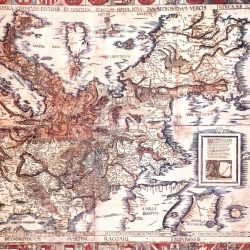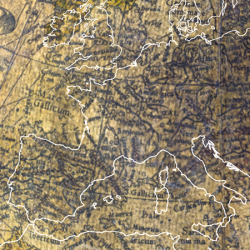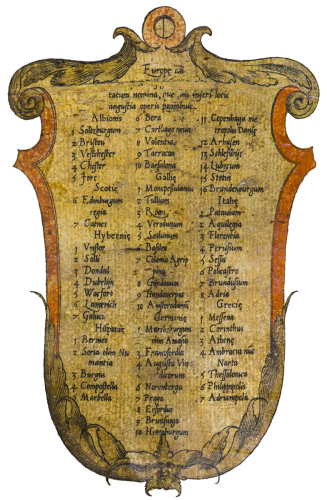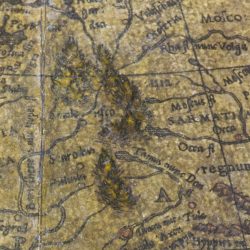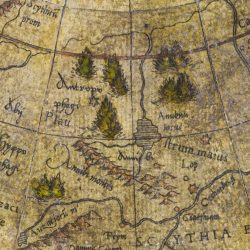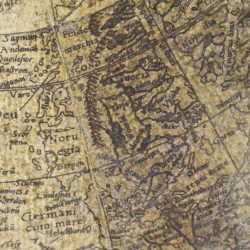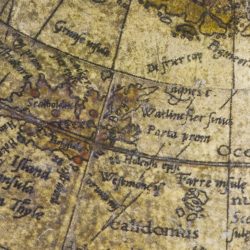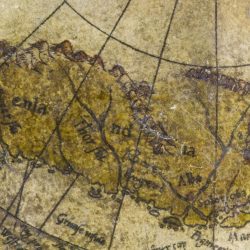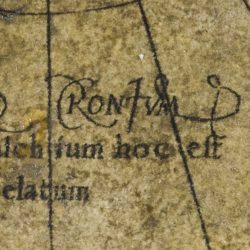Europe
- Ptolemy’s Europe
- Waldseemüller’s Europe
- Mercator’s Europe
Mercator corrected a major error in Ptolemy’s conception of the longitudinal reach of Europe. He contended that the continent lay much farther east and thereby also rectified the latitude of the Canary Islands. This resulted in a reduction of the Mediterranean’s overextension by Ptolemy. Even though its proportions were still far off the mark, this correction nevertheless represented a major stride forward, especially for navigation.
Europae aliquot insigniorum civitatum nomina, quae suis inferi locis angustia operis prohibuit
Here are the names of a few famous cities in Europe that lack of space prevented Mercator from indicating below their position.
1 Saltzburgum (Salisbury)
2 Bristou (Bristol)
3 Vestchester
4 Chester (Chester)
5 Jorc (York)
Scotiae (Scotland)
6 Edinburgum regia (Edinburgh)
7 Catnes
Hyberniae (Ireland)
1 Unflor
2 Solli
3 Dondal (Dundalk)
4 Dubelyn (Dublin)
5 Wacfort (Wateford)
6 Lamerich (Limerick)
7 Galuei (Galway)
1 Bermeo (Bermeo)
2 Soria olim Numantia (Soria formerly Numance)
3 Burgus (Burgos)
4 Compostella (Compostella)
5 Marbella (Marbella)
6 Bera
7 Carthago nova (Cartagena)
8 Valentia (Valencia)
9 Tarracon (Tarragona)
10 Barsalona (Barcelona)
Galliae (Gaule)
1 Monspessulanus (Montpellier)
2 Tullium (Toul)
3 Roari (Rouen)
4 Verodunum (Verdun)
5 Sedunum (Sion)
6 Basilea (Basel)
7 Colonia Agrippina (Cologne)
8 Gandanum (Ghent)
9 Amsterodamum (Amsterdam)
1 Marcheburgum olim Amasia
3 Francofordia (Frankfurt)
4 Augusta Vindelicorum (Augsburg)
6 Norenberga (Nuremberg)
7 Praga (Prague)
8 Erfordia (Erfurt)
9 Brunsuiga (Brunswick)
10 Hamburgum (Hamburg)
11 Copenhaga metropolis Daniae (Copenhagen capital of the Danes)
12 Arhusen (Aarhus)
13 Schlesibyc (Schelswig)
14 Lubecum (Lübeck)
15 Stetin (Szczecin)
16 Brandenburgum (Brandenburg)
1 Patavium (Padova)
2 Aquilegia (Aquila)
3 Florentia (Florence)
4 Perusium (Perugia)
5 Sessa
6 Policastro (Policastro Bussentino)
7 Brundusium (Brindisi)
8 Adria
Greciae (Greece)
1 Messena (Messina)
2 Corinthus (Corinth)
3 Athenae (Athns)
4 Ambracia nunc Narta (Ambracie now Nartë)
5 Thessalonica (Thessaloniki)
6 Philippipolis
7 Adrianopolis (Edirne)
- Muscovy
- Ukraine
- Norway
Mercator made sweeping improvements to the cartography of Northern Europe by drawing on the Carta Marina by the Swedish writer Olaus Magnus. Finland extends all the way up to the White Sea, however, no doubt in reference to the map of Scandinavia drawn by Jakob Ziegler. But Mercator mainly strove to correct the area between Greenland and the Ural Mountains including :
- Ukraine and southern Russia (Scythia),
- Lithuania and Moscow more or less (Sarmatia),
- Scandinavia (Scandia),
- Scotland (Scotia),
- Iceland (Islandia),
- the islands in the Sea of Norway (Deucaledonius maris)
- Iceland
- Greenland
- Mare Cronium
On Mercator’s globe the regions of the North Pole include only Island insula olim Thyle, Grimse insula, Groenlandia, its neighbour Margaster and a few smaller islands situated along the southern coast of Groenlandia. Greenland is part of the continent of North America. Its uninhabited portion extends beyond the pole and measures nearly 30 degrees at its widest point.
The rest of the Arctic area is shown as seas, of which Mercator distinguishes Tabin Mare and Mare Cronium vel Amalchium hoc est congelatum.
Greenland, with its two settlements Alba and Solotobab inhabited by the Screlingers, its mountain chains and its Diver and Thor Rivers, occupies almost half the circumpolar regions.
The northern tips of Norway, with its province Scricfinnia, of Russia, with Juhra regio ex qua Hungaros prodiisse volunt, and of Asia, with the Tabin headland and the Belgian desertum, extend up to the latitude of the inhabited part of Groenlandia. They could therefore also be considered as forming part of the northern regions on Mercator’s globe.
We should not be surprised by the various representations of the circumpolar areas. In 1572 Abraham Ortelius (1527-1598) noted that nothing was yet known about the regions near the North Pole, or whether they were made of land or ocean, and that a host of tales were told about these remote climes. On his planisphere in 1569 Mercator would depict the arctic regions quite differently.
Find out more
- Carta marina : par Olaus Magnus, document numérisé, Bibliothèque numérique mondiale : Bibliothèque nationale de Suède.
- Theatrum Orbis Terrarum : par Abraham Ortelius, document numérisé, Library of Congress.
